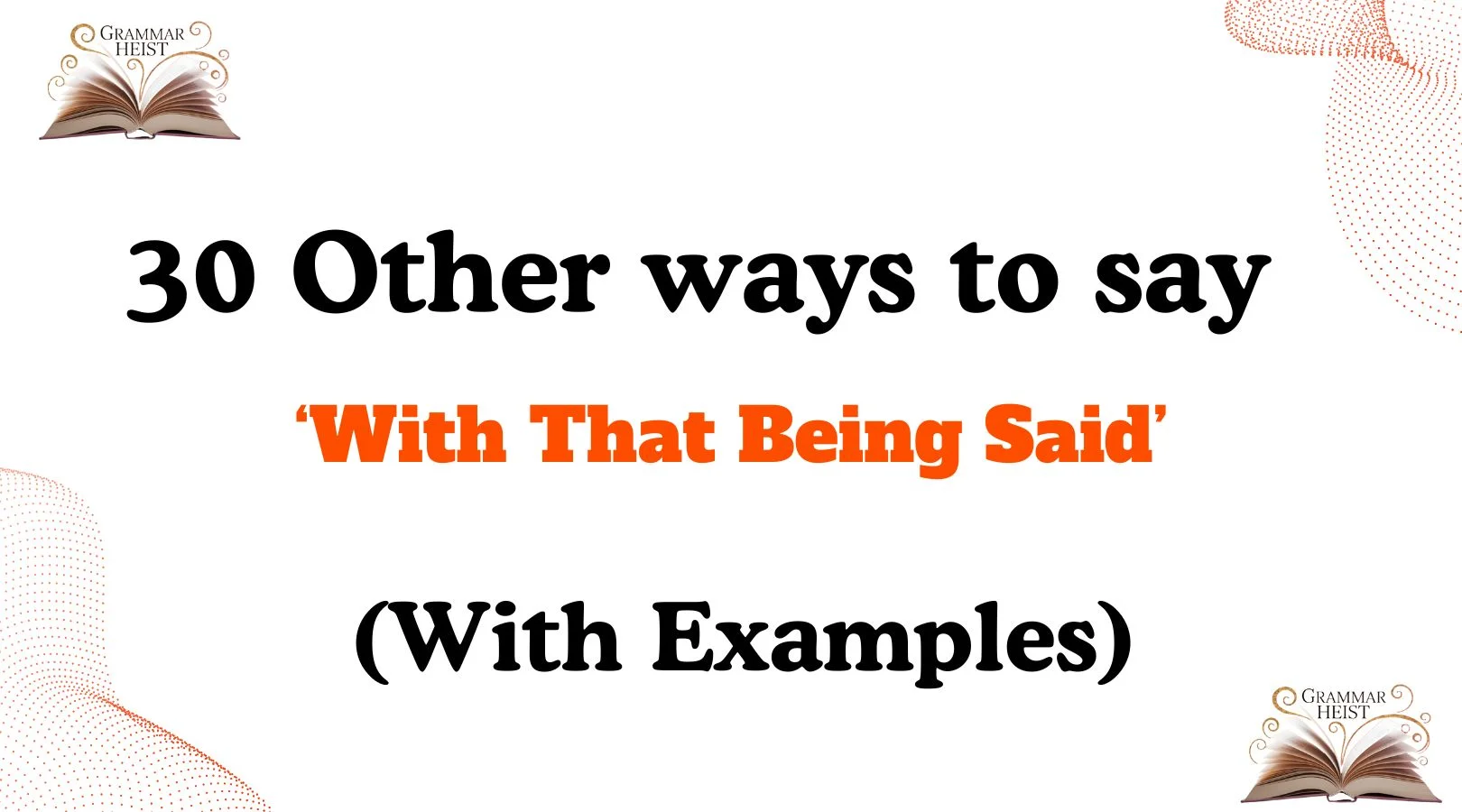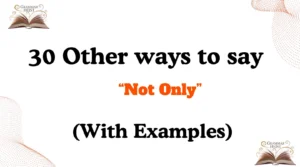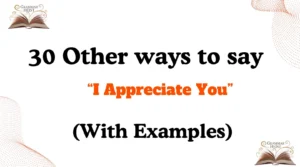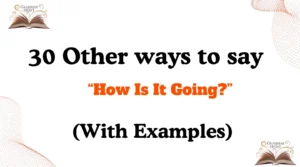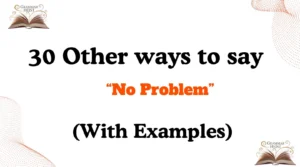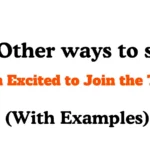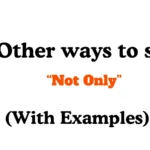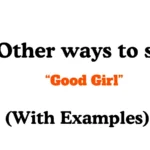Finding the right words in communication is more than just a formality—it’s about expressing care, respect, and clarity. The phrase “with that being said” is often used to transition between thoughts, but repeating it too often can make your writing or speech feel predictable or mechanical.
This article offers 30 thoughtful alternatives to the phrase “with that being said.” These choices allow you to maintain a warm, professional, and polished tone while adding variety to your conversations, emails, or presentations.
What Does “With That Being Said” Mean?
The phrase “with that being said” is a transitional expression. It’s used to connect two ideas—usually when you’re about to share a point that contrasts, qualifies, or builds upon what you just said.
It signals to the listener or reader: “I’ve made one point, and now here’s another you should consider.”
Is It Professional/Polite to Say “With That Being Said”?
Yes, the phrase is professional and polite. It’s widely accepted in emails, meetings, and presentations. However, overuse may feel repetitive or overly formal. Replacing it with fresh alternatives can make your message sound more natural and engaging.
Pros or Cons
Pros:
- Helps transition smoothly between points
- Widely understood in both casual and professional settings
- Neutral and polite in tone
Cons:
- Can sound cliché if used too often
- May come across as filler rather than meaningful transition
- Alternatives can sometimes be more precise or warm
1. That Being the Case
Scenario: Used when introducing a conclusion based on prior information.
Examples:
- That being the case, we’ll move forward with the new plan.
- That being the case, let’s prioritize quality over speed.
- That being the case, we’ll schedule another meeting.
Tone: Professional, logical, and clear.
Explanation: This phrase works well when you want to show that your conclusion directly follows from the facts or ideas you’ve already discussed.
2. Having Said That
Scenario: Best for casual but respectful transitions in speech or writing.
Examples:
- I agree with your point. Having said that, we need to consider budget limits.
- She’s talented. Having said that, experience still matters.
- The project is on track. Having said that, there are some risks.
Tone: Conversational yet respectful.
Explanation: This alternative is slightly less formal than “with that being said,” making it sound more natural in emails or friendly discussions.
3. Nevertheless
Scenario: Used when emphasizing a point that contrasts what was just mentioned.
Examples:
- The plan is risky. Nevertheless, it’s worth trying.
- It was raining. Nevertheless, they continued the event.
- She was nervous. Nevertheless, she performed well.
Tone: Formal and assertive.
Explanation: This phrase adds weight to your statement, often used in writing where you want to show determination or highlight a contrasting idea.
4. Even So
Scenario: When acknowledging one idea but introducing a contrasting point.
Examples:
- It’s a tough market. Even so, we should try our best.
- She was tired. Even so, she completed the work.
- It’s expensive. Even so, it’s worth the investment.
Tone: Balanced and thoughtful.
Explanation: This alternative works well in empathetic communication, showing you recognize a difficulty but still emphasize persistence.
5. All the Same
Scenario: Used in casual conversations to transition into a contrast or highlight a different perspective.
Examples:
- It’s late. All the same, we should finish this task today.
- He’s inexperienced. All the same, he has potential.
- We had little time. All the same, the work was excellent.
Tone: Casual and conversational.
Explanation: This phrase is warm and less formal, making it suitable for friendly discussions or light professional settings.
6. In Light of That
Scenario: When your next point is a direct result of what was just mentioned.
Examples:
- In light of that, we’ll adjust the budget.
- In light of that, training is essential.
- In light of that, we need more preparation.
Tone: Formal and reflective.
Explanation: Best used in business emails or reports, where you want to show cause-and-effect reasoning.
7. At the Same Time
Scenario: To show acknowledgment of one point while raising another side.
Examples:
- I see your point. At the same time, we can’t ignore the risks.
- She’s reliable. At the same time, deadlines are crucial.
- It’s a good plan. At the same time, let’s keep alternatives ready.
Tone: Neutral and considerate.
Explanation: This phrase communicates balance, making it good for conversations where you want to respect multiple perspectives.
8. With This in Mind
Scenario: To guide someone to think forward based on the previous statement.
Examples:
- With this in mind, let’s finalize the strategy.
- With this in mind, the deadline must be extended.
- With this in mind, more resources are required.
Tone: Encouraging and guiding.
Explanation: Perfect when you want to gently lead others toward a conclusion or decision.
9. Given That
Scenario: Used when linking a reason to a logical next point.
Examples:
- Given that it’s urgent, we should act quickly.
- Given that budgets are tight, let’s reprioritize.
- Given that training is needed, we’ll schedule it next week.
Tone: Rational and straightforward.
Explanation: Works well in both formal and informal contexts where logic is important.
10. For That Reason
Scenario: To emphasize the cause-and-effect relationship in a clear way.
Examples:
- The product is popular. For that reason, we increased production.
- The team is busy. For that reason, deadlines were extended.
- The results were strong. For that reason, we’re moving ahead.
Tone: Professional and precise.
Explanation: Strong in presentations or formal writing, as it highlights reasoning clearly.
11. Accordingly
Scenario: When making a direct, formal transition in reports or instructions.
Examples:
- The system is down. Accordingly, the update is postponed.
- Sales rose. Accordingly, bonuses will be higher.
- The plan failed. Accordingly, we’ll reassess our strategy.
Tone: Highly formal and businesslike.
Explanation: Best for professional emails, reports, or academic writing where formality is expected.
12. As a Result
Scenario: Explains the outcome or impact of the previous statement.
Examples:
- The project was delayed. As a result, delivery is pushed back.
- She worked hard. As a result, she got promoted.
- The budget was cut. As a result, we adjusted plans.
Tone: Clear and factual.
Explanation: Great for workplace communication to show direct outcomes without emotional bias.
13. For That Matter
Scenario: Adds emphasis or extends a point to a broader idea.
Examples:
- I enjoy reading. For that matter, I like writing too.
- He’s skilled at design. For that matter, he’s a great leader.
- They’re good at sports. For that matter, they excel in academics.
Tone: Conversational and engaging.
Explanation: Best for informal and semi-formal situations, where you want to smoothly expand on an idea.
14. Because of This
Scenario: To point directly to consequences or reasons.
Examples:
- The weather was bad. Because of this, the event was canceled.
- She studied hard. Because of this, she succeeded.
- They prepared well. Because of this, the results were excellent.
Tone: Simple and explanatory.
Explanation: Works in both personal and professional messages, easy for everyone to understand.
15. In Turn
Scenario: Shows a chain reaction or sequence of events.
Examples:
- He taught me well. In turn, I shared the knowledge with others.
- The company invested more. In turn, employees performed better.
- She encouraged me. In turn, I motivated my team.
Tone: Professional yet thoughtful.
Explanation: Useful when explaining reciprocal actions or effects in clear, concise ways.
16. On That Note
Scenario: Used when smoothly moving from one point to a related conclusion.
Examples:
- We’ve covered the challenges. On that note, let’s discuss solutions.
- It’s been a long meeting. On that note, we’ll wrap up soon.
- The product is ready. On that note, let’s plan the launch.
Tone: Smooth and conversational.
Explanation: Ideal for presentations and team discussions, where you want a natural flow without sounding too formal.
17. To That End
Scenario: When highlighting an action or decision tied to a specific purpose.
Examples:
- We want efficiency. To that end, we’re automating tasks.
- We aim for growth. To that end, we’re expanding overseas.
- We value innovation. To that end, new projects are encouraged.
Tone: Formal and purposeful.
Explanation: Perfect for strategic conversations, showing you are aligning actions with goals.
18. In Any Case
Scenario: When shifting or softening from one idea to another.
Examples:
- We might face delays. In any case, we’ll be prepared.
- It could rain tomorrow. In any case, the event is indoors.
- He’s busy today. In any case, we’ll send the email later.
Tone: Casual and flexible.
Explanation: Works well in friendly discussions or less formal emails where tone should stay light.
19. In Conclusion
Scenario: To signal that you’re wrapping up thoughts with a final point.
Examples:
- In conclusion, teamwork is key to success.
- In conclusion, we recommend moving forward with Plan A.
- In conclusion, her efforts deserve recognition.
Tone: Formal and definitive.
Explanation: Best used in reports, presentations, or essays, not casual conversations.
Read More:30 Other Ways to Say ‘Please Disregard My Previous Email’ (With Examples)
20. After All
Scenario: To add emphasis by showing reasoning or justification.
Examples:
- He should win—after all, he trained the hardest.
- We need a break—after all, it’s been a long week.
- She deserves the award—after all, her work was outstanding.
Tone: Emphatic and persuasive.
Explanation: Effective in conversations or emails when you want to stress fairness or common sense.
21. Then Again
Scenario: To introduce a counterpoint or reconsideration.
Examples:
- I like the plan. Then again, it may be risky.
- We could leave now. Then again, traffic might be heavy.
- She seems strict. Then again, she’s very fair.
Tone: Casual and reflective.
Explanation: Best for informal communication, adding nuance and balance to opinions.
22. Therefore
Scenario: When logically showing the outcome of a prior statement.
Examples:
- The team worked hard. Therefore, the project succeeded.
- We lacked resources. Therefore, delays were expected.
- He qualified. Therefore, he’ll move to the next round.
Tone: Formal and logical.
Explanation: Common in academic, professional, and business writing, ensuring clarity in reasoning.
23. Thus
Scenario: A concise way to show a conclusion or result.
Examples:
- It rained heavily. Thus, the match was canceled.
- He didn’t study. Thus, he failed the test.
- We need funds. Thus, we’ll seek investors.
Tone: Formal and precise.
Explanation: Often found in formal writing or presentations, offering a polished, academic feel.
24. Hence
Scenario: Used to present a direct conclusion or reason.
Examples:
- The product is popular. Hence, the demand is high.
- She was late. Hence, the missed opportunity.
- We lacked data. Hence, the cautious approach.
Tone: Formal and sharp.
Explanation: Best in reports, research, or professional writing where you want to be concise and clear.
25. In Effect
Scenario: When summarizing the impact or essence of something.
Examples:
- The law changed. In effect, it protects workers better.
- The deal was canceled. In effect, we start from scratch.
- The plan shifted. In effect, the timeline was extended.
Tone: Analytical and professional.
Explanation: Useful in policy, business, or legal communication, highlighting real-world consequences.
26. To Put It Another Way
Scenario: When rephrasing for clarity.
Examples:
- To put it another way, we need to simplify the process.
- To put it another way, customer service is our priority.
- To put it another way, we can’t ignore the risks.
Tone: Clear and explanatory.
Explanation: Great for meetings or emails, ensuring everyone fully understands your point.
27. In Other Words
Scenario: To simplify or restate your message.
Examples:
- In other words, we need more time.
- In other words, the results exceeded expectations.
- In other words, let’s stay focused.
Tone: Friendly and clarifying.
Explanation: A go-to phrase for everyday conversations, helping your message sound approachable and easy to grasp.
28. To Sum Up
Scenario: When closing a discussion by condensing key points.
Examples:
- To sum up, the project was a success.
- To sum up, teamwork made it possible.
- To sum up, we’ll continue improving.
Tone: Conclusive but approachable.
Explanation: Perfect for team meetings or short speeches, giving a quick, clear ending.
29. On the Whole
Scenario: When offering a broad conclusion after considering details.
Examples:
- On the whole, the results were positive.
- On the whole, the team performed well.
- On the whole, the strategy worked.
Tone: Balanced and measured.
Explanation: Useful for evaluations or reports, where you want to give an overall impression.
30. In Summary
Scenario: To provide a concise conclusion after explaining details.
Examples:
- In summary, the campaign achieved its goals.
- In summary, more work is needed for improvement.
- In summary, we’re moving in the right direction.
Tone: Formal and concise.
Explanation: Best for presentations, reports, or emails, ensuring the key point is highlighted clearly.
Conclusion
Using alternatives to “with that being said” allows your communication to sound fresh, empathetic, and tailored to the situation. Whether you need something formal like “therefore” or conversational like “then again,” these phrases help you transition smoothly and connect your thoughts with care.

Mia Rose is a skilled language expert with a deep passion for helping individuals master the art of writing and communication. With years of experience in the field, Marie brings a thoughtful and tailored approach to grammar, style, and language improvement. Her goal is to empower others to express themselves with clarity, precision, and confidence in every written word.
